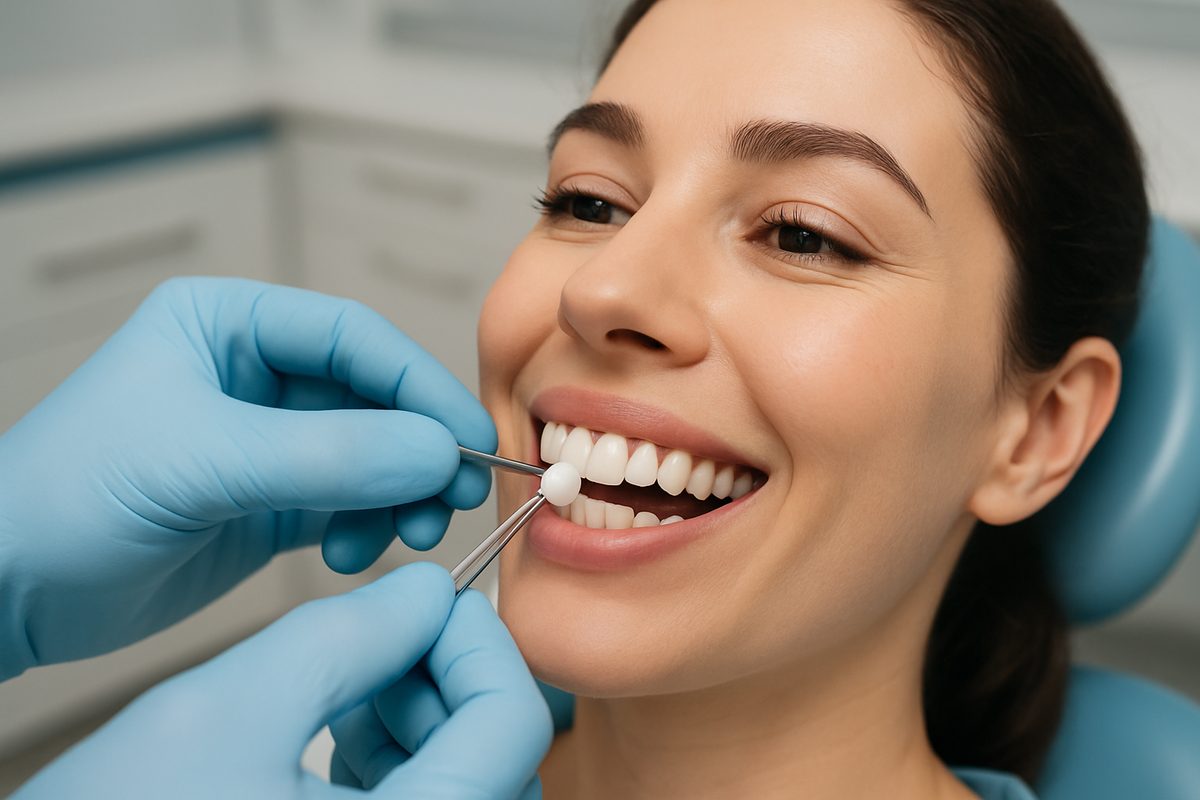Veneers are thin shells bonded to the front of teeth to improve their appearance. People choose veneers for stained, chipped, uneven, or worn teeth to get a brighter, more even smile. This guide explains what veneers are, the main types, who is a good candidate, the treatment steps, care and costs, and how to choose a provider. The term “venier dental” appears here to match search intent and help you find cosmetic options.
What Are Veneers?
Veneers are custom-made covers that attach to the visible surface of teeth. Porcelain veneers are made in a lab and mimic natural enamel with a lifelike shine and translucency. Composite veneers (bonding) are sculpted directly on the tooth using tooth-colored resin. Both types are bonded with dental cement after preparing the tooth surface. A typical timeline runs from consultation and planning to tooth prep, lab work (for porcelain), and final bonding, generally taking two to four weeks for porcelain and one visit for composite.
Types of Veneers
Porcelain veneers
Porcelain veneers offer a very natural look and resist stains. They usually last 10–15 years or longer with good care. Downsides include higher cost and the need for lab fabrication, which means at least two visits. Porcelain is strong but can chip with hard impacts.
Composite veneers (bonding)
Composite veneers are placed directly by the dentist in one visit. They cost less and are easier to repair if damaged. However, composite tends to stain more and usually lasts 5–7 years. Bonding is a good choice for smaller cosmetic fixes or as a more affordable trial before porcelain.
No-prep / minimal-prep options (e.g., lumineers)
No-prep or minimal-prep veneers require little to no enamel removal. They can preserve tooth structure and reduce sensitivity. The trade-offs are that they may look bulkier or require careful case selection. These are best for patients with minor cosmetic concerns and good bite alignment.
Who Is a Good Candidate?
Good candidates want to improve the appearance of front teeth and have healthy gums and no active decay. Common reasons include stubborn stains, chips, small gaps, minor misalignment, and worn edges. If you have significant decay, gum disease, or severe bite problems, those must be treated first. Sometimes crowns, orthodontics, or implants are better choices for large restorations or major alignment issues.
The Veneer Treatment Process
Consultation & planning
The dentist discusses your smile goals and examines teeth and gums. Digital scans or impressions (for example, iTero) and photos help plan shape and shade. The team will show options and may create digital mockups or trial smiles so you can preview results.
Tooth preparation & temporaries
For porcelain, a thin layer of enamel is usually removed to make room for the veneer. Local anesthetic minimizes discomfort. Temporary veneers protect teeth while the lab creates the final pieces. Sensitivity can occur but is often short-lived and managed with desensitizing toothpaste or medication.
Lab work, try-in, and final bonding
The lab matches color and fabricates veneers. At try-in, the dentist checks fit, shape, and shade and makes adjustments. Final bonding uses specialized cement and curing lights. After bonding, the dentist polishes margins and gives aftercare instructions.
Maintenance, Longevity & Risks
Care for veneers like natural teeth: brush twice daily, floss, and see your dentist for regular checkups. Avoid biting hard objects or using teeth as tools. Porcelain veneers often last 10–15+ years; composite veneers last around 5–7 years. Risks include sensitivity, chipping, and the need for replacement over time. If a veneer fails, it can usually be replaced. Nightguards protect veneers for those who grind teeth.
Costs & Alternatives
Costs vary by material, number of teeth, complexity, and lab fees. Porcelain costs more than composite. Price per tooth can range widely depending on location and provider. Alternatives include professional teeth whitening (for stains), bonding for small fixes, crowns for heavily damaged teeth, and orthodontics for alignment issues. Your dentist will recommend the least invasive option that meets your goals.
How to Choose a Provider for “venier dental”
Look for before-and-after photos and documented patient outcomes. Read reviews and check that the practice explains the process and cost clearly. Digital tech—like intra-oral cameras, iTero scanners, and 3D planning—improves predictability. Ask about lab partnerships, financing, and a clear consultation process. A provider who offers a conservative, individualized plan and mockups or temporaries can help ensure you get the look you want.
Why Consider Broadway Smile Boutique for Veneers (Glendale, CA)
Broadway Smile Boutique offers concierge-style cosmetic care near Glendale, CA, with a focus on minimally invasive techniques. Dr. David Shirinian uses iTero digital scanning, intra-oral cameras, CBCT when needed, and in-house 3D printing to support predictable veneer outcomes. The practice highlights before-and-after cases, transparent financing options, and personalized treatment planning to help make veneers more accessible.
Frequently Asked Questions
Will veneers hurt? You may feel mild sensitivity during and after prep, but local anesthetic and modern techniques minimize discomfort. Sensitivity usually fades in days to weeks. How long do veneers last? Porcelain veneers commonly last 10–15 years or more. Composite veneers typically last 5–7 years with proper care. Can veneers be whitened? No. Veneer materials do not respond to whitening. Whitening natural teeth before veneer shade selection helps match color. Does insurance cover veneers? Most cosmetic veneers are not covered by dental insurance. Coverage depends on your plan and whether treatment is deemed restorative. Ask your carrier and the office about financing. How many veneers should I get? This depends on your smile goals. Many patients start with the visible front 6–8 teeth for a balanced look. Your dentist will recommend the appropriate number based on proportion and symmetry. If you’re curious whether veneers are right for you, schedule a consultation to review goals and options. Broadway Smile Boutique — 1100 E Broadway, #302, Glendale, CA 91205. New patient phone: 818-600-7835. Current patient phone: 818-900-1100.






